Fengdu Ghost City is located on the north bank of the Yangtze River in Fengdu County, Chongqing, and is a national 4A-level tourist attraction. The scenic area is renowned for its unique "ghost culture", integrating Confucianism, Taoism, and Buddhism, and combining folk legends, religious beliefs, and traditional culture. It is the most famous ghost culture-themed scenic spot in China. Covering an area of approximately 1.5 square kilometers, the scenic area boasts a series of ancient buildings related to underworld legends, such as the Naihe Bridge, Ghost Gate Pass, Huangquan Road, Wangxiang Terrace, and Tianzi Hall. There are about 30 existing ancient buildings, most of which were first built in the Han Dynasty. After successive renovations and expansions over the dynasties, they have formed the grand-scale and rigorous layout seen today.
Historical Culture
The history of Fengdu Ghost City can be traced back to the Eastern Han Dynasty. According to historical records, in the 2nd year of Yongyuan during the reign of Emperor He of the Eastern Han Dynasty (90 AD), two alchemists, Yin Changsheng and Wang Fangping, successively attained immortality through cultivation on Pingdu Mountain in Fengdu. Later generations combined the characters "Yin" and "Wang" to form "Yin Wang" (King of the Underworld), and Fengdu gradually became legendary as the location of the "Underworld".
Over time, many literati and poets, such as Li Bai, Du Fu, and Su Shi, visited Fengdu and left poems and odes, which made Fengdu Ghost City even more famous. During the Ming and Qing dynasties, folk belief in ghost culture reached its peak, and a large number of buildings related to the underworld were constructed here, further strengthening Fengdu's image as the "Ghost City".
The ghost culture carried by Fengdu Ghost City is not about promoting superstition. Instead, through eerie and terrifying scenes and stories, it urges people to do good deeds and warns the world to accumulate virtue and perform good acts. The ideas of karmic retribution and reward for good and punishment for evil contained in it are a special embodiment of ethical and moral concepts in traditional Chinese culture.
Main Attractions
Naihe Bridge
The Naihe Bridge consists of three stone arch bridges of the same size and shape, built side by side. The bridge deck is narrow, and under the bridge, there are many evil ghosts sculpted in the Blood River Pool. According to folk legend, good people can cross the bridge smoothly, while evil people will shake or even fall into the "Blood River Pool" when crossing. With a length of about 6 meters and a width of about 1.5 meters, it is a highly symbolic attraction in Fengdu Ghost City and a must-visit spot for tourists.
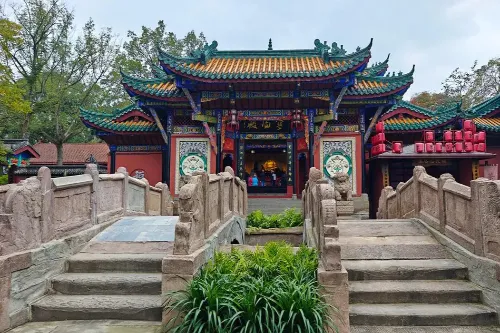
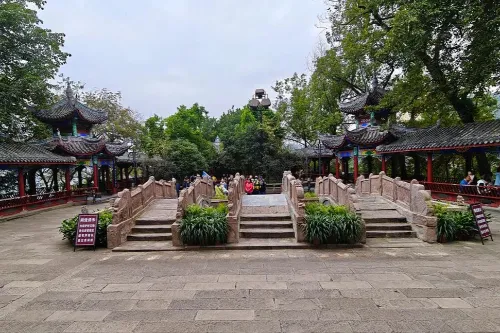
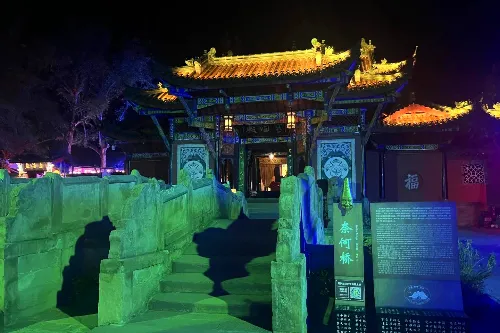
Ghost Gate Pass
Ghost Gate Pass is an ancient-style pavilion with four cornered eaves. The dark mountain gate is as vast as the universe, with a sense of antiquity. On the blood-rusted horizontal plaque, the terrifying three characters "Ghost Gate Pass" are engraved. According to folk legend, after death, one must pass through Ghost Gate Pass to enter the Underworld. Its architectural style is eerie and terrifying, making people shudder at the sight.
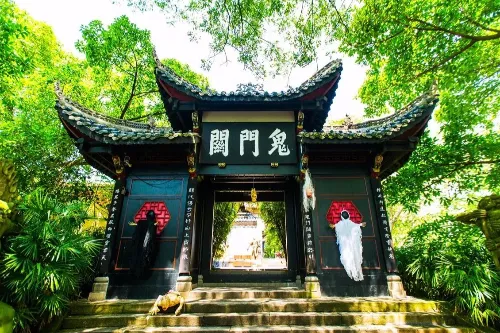
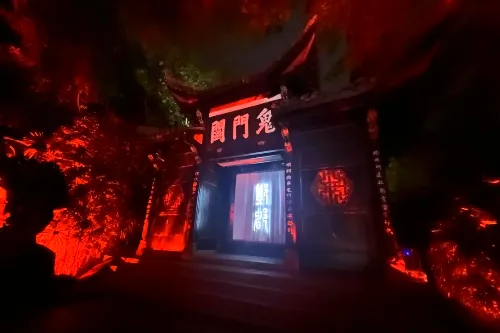
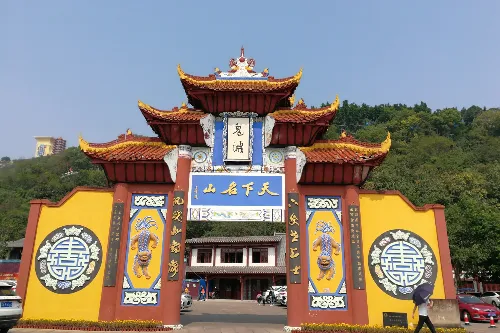
Tianzi Hall
Tianzi Hall is the core building of the Ghost City, covering an area of 2431 square meters, consisting of three parts: the memorial archway, the mountain gate, and the main hall. Inside the hall, there are statues of ghosts and gods such as the Six Cao Underworld, the Ten Yama Kings, and the Four Judges, as well as scenes of the Eighteen Levels of Hell, which are vivid and eerie. Here, tourists can gain an in-depth understanding of the ancient people's imagination and construction of the underworld judicial system.

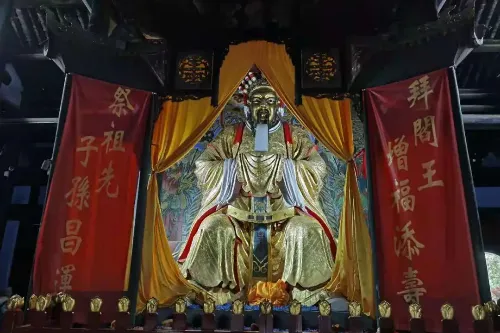
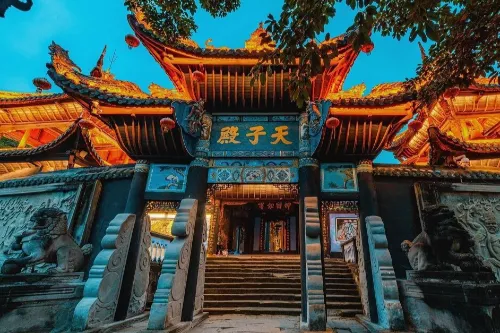
Huangquan Road
Huangquan Road is a bluestone path about 100 meters long and 2 meters wide, with an uneven surface. On both sides of the road, ancient trees tower into the sky, and the path winds through the peaks. There are the rustling of pine waves and the sounds of ghost cries, creating an eerie atmosphere, simulating the legendary path that one must take to the underworld after death.
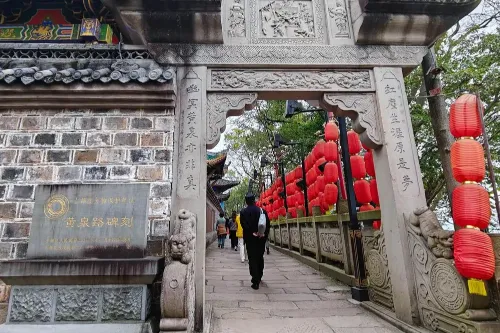
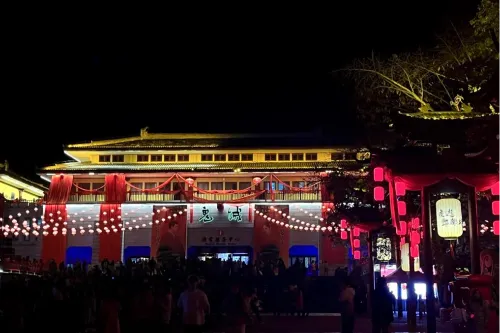
Wangxiang Terrace
Wangxiang Terrace is about 20 meters high, with a semicircular platform surface. The platform is divided into two layers, surrounded by carved stone railings, and the platform surface is paved with blue bricks. Legend has it that after death, the deceased must climb Wangxiang Terrace to have a final look at their hometown and relatives. Standing on the terrace and looking into the distance, the scenery of the Yangtze River is fully visible.
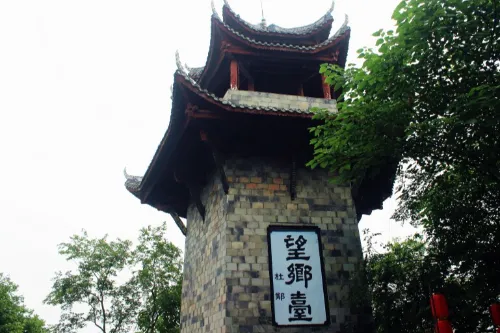
Granny Meng's Cottage
Granny Meng's Cottage is located beside the Naihe Bridge, a characteristic building built based on the folk legend of "Granny Meng boiling soup". Inside the cottage, there is a statue of Granny Meng, holding a soup ladle with a calm expression, as if she is handing over the Meng Po Soup that can make the passing spirits forget their past lives. The interior of the cottage is simply and quaintly furnished, with murals on the walls depicting the scene of "drinking soup to forget the past", which echoes with the Naihe Bridge, Wangchuan River and other landscapes, vividly showing the key link of the underworld reincarnation in folk legends.

Yuhuang Hall
The statue of the Jade Emperor enshrined in the hall is 7 meters high, making it the largest statue on the famous mountain. The Jade Emperor governs all gods, earth spirits, and humans, and is in charge of the three realms, ten directions, four births, and six paths. The hall also enshrines gods such as the Queen Mother of the West and Taishang Laojun.
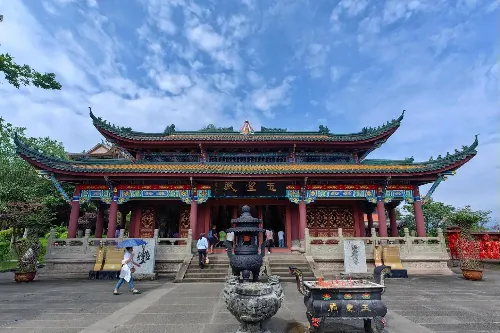
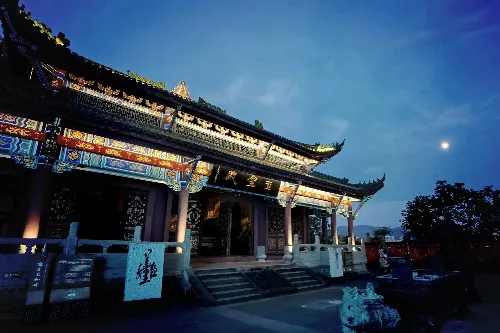
Tour Route
After entering the scenic area, tourists can first visit the Naihe Bridge to experience its unique cultural implications; then walk along Huangquan Road to feel the eerie atmosphere; then reach Ghost Gate Pass to appreciate the mystery of ancient architecture; then go to Tianzi Hall to gain an in-depth understanding of the underworld culture; finally climb Wangxiang Terrace to overlook the scenery of the Yangtze River. During the tour, you can stay and take photos at various attractions according to your interests, and the entire tour takes about 2-3 hours.
Tour Suggestions
- It is recommended to learn about the historical and cultural background of Fengdu Ghost City in advance, which can be done by consulting materials or watching related documentaries, so as to better understand the connotation of the attractions during the tour.
- Some scenes in the scenic area are quite eerie and terrifying. Timid tourists or those with children can prepare mentally in advance, or choose to visit in the early morning.
- When visiting in summer, pay attention to sun protection and heatstroke prevention measures; when visiting in winter, keep warm. There are many steps in the scenic area, so it is recommended to wear comfortable sports shoes.
- When tasting food, you can go to regular restaurants or characteristic food streets in Fengdu County, which can not only ensure food safety but also taste authentic flavors.
- There are many "ghost culture" attractions in the scenic area, and some scenes are quite eerie. Tourists with children need to guide them in advance.
Matters Needing Attention
- Respect the religious and cultural customs in the scenic area, and do not arbitrarily perform inappropriate behaviors or make inappropriate comments on statues, buildings, etc.
- Take good care of the scenic environment, do not spit, litter, or scribble on ancient buildings.
- Pay attention to safety during the tour, especially in areas with many steps and dim light. Walk carefully to avoid falling.
- There may be staff dressed as ghosts and gods interacting with tourists in the scenic area. If you do not like such interactions, you can politely refuse to avoid conflicts.
- When buying souvenirs, choose regular stores and ask about the price in advance to avoid unnecessary disputes.
Transportation
- Airplane: Tourists can first arrive at Chongqing Jiangbei International Airport, take a long-distance bus to Fengdu at the airport's long-distance transfer center, with a journey of about 3 hours; or take rail transit line 3 from the airport to Chongqing North Railway Station, transfer to a high-speed rail to Fengdu Station, then take a taxi or bus to the scenic area, with a high-speed rail journey of about 1.5 hours.
- Train: After arriving at Fengdu Station by high-speed rail or bullet train, you can take buses such as No. 109 and No. 112 directly to the scenic area, or choose to take a taxi, with a journey of about 15 minutes.
- Self-driving: Enter "Fengdu Ghost City" through navigation software, and go via routes such as Shanghai-Chongqing Expressway. The scenic area has a parking lot, making parking convenient.
Opening Hours
Fengdu Ghost City is open all year round. In summer (April 1 - October 31), the opening hours are 08:00 - 18:00; in winter (November 1 - March 31 of the following year), the opening hours are 08:30 - 17:30.
Tickets
The ticket price for Fengdu Ghost City scenic area is 90 yuan per person. Special groups such as students and the elderly can enjoy half-price or other discounts according to relevant policies. For specific preferential information, you can query through the official channels of the scenic area.
You can search for the official WeChat public account of the scenic area "鬼城名山" to get the latest news or buy tickets online.
Online Booking
Click here to jump to the Trip.com ticketing platform for ticket purchase.


